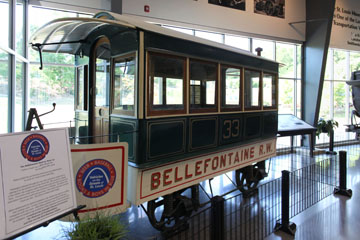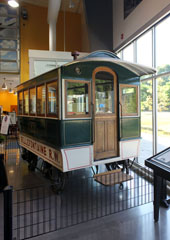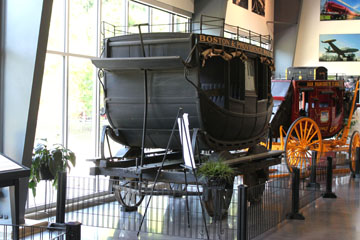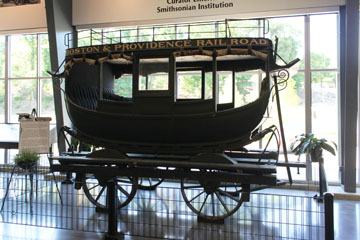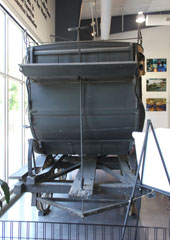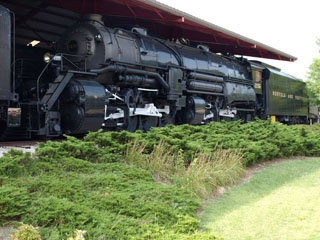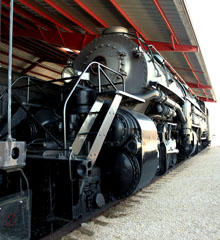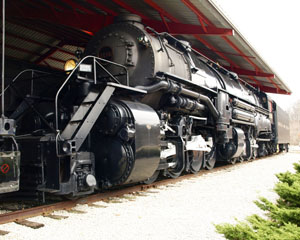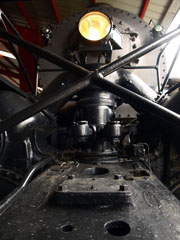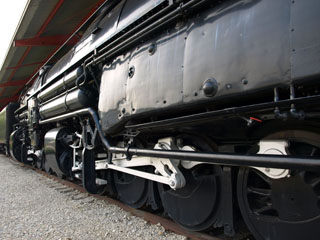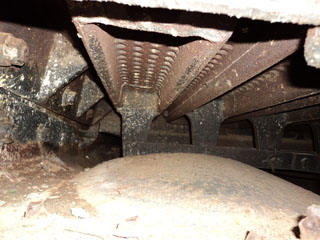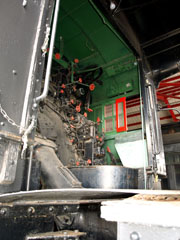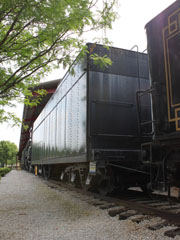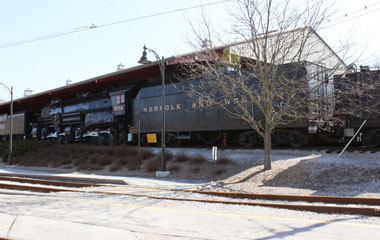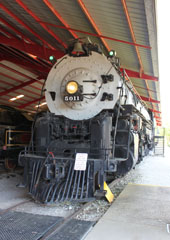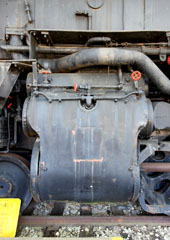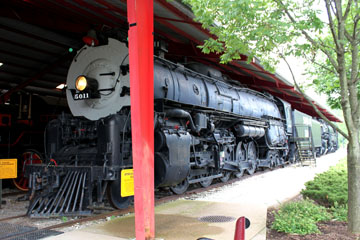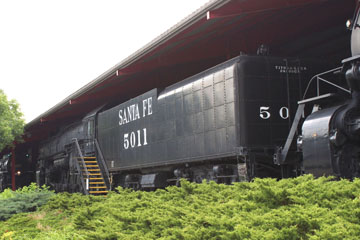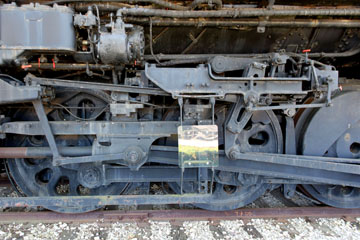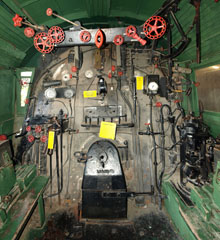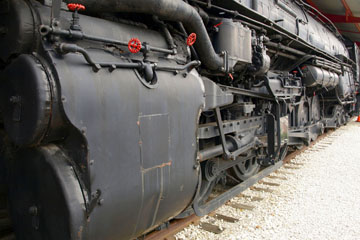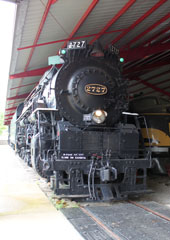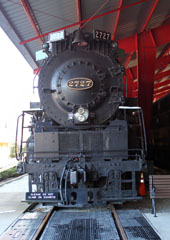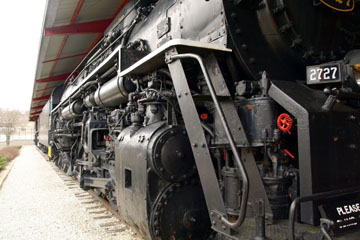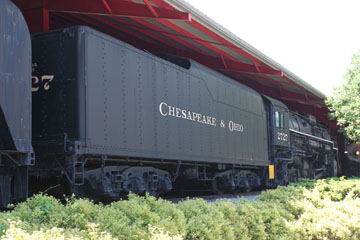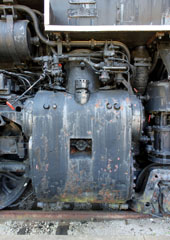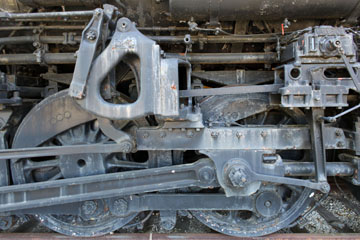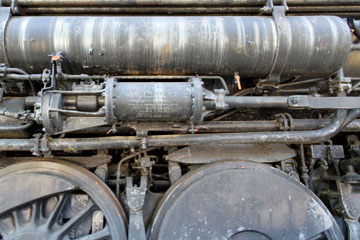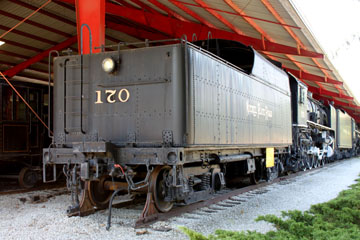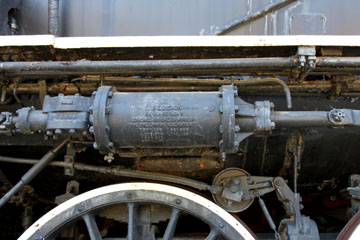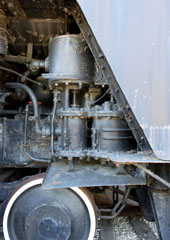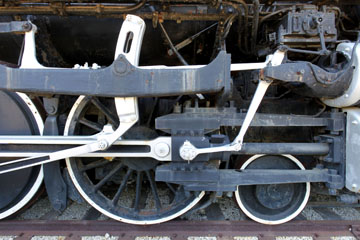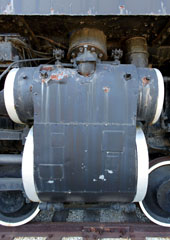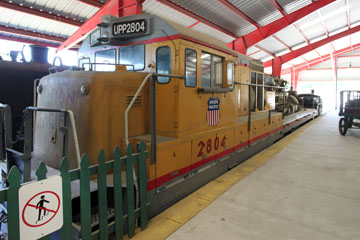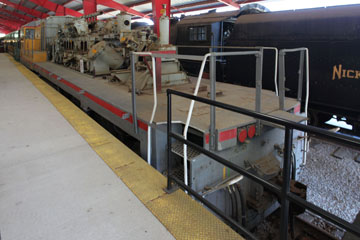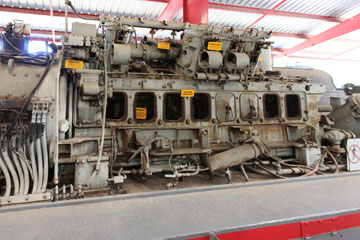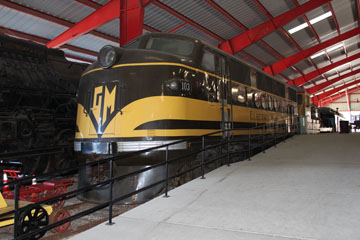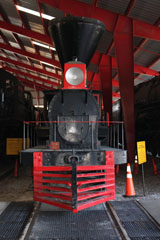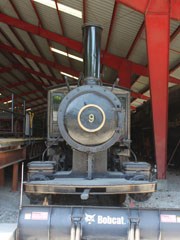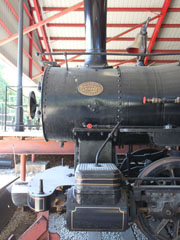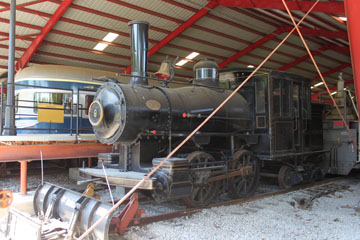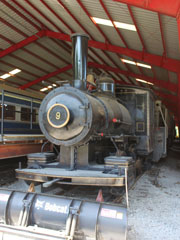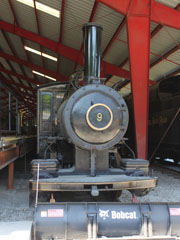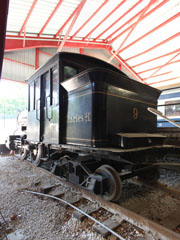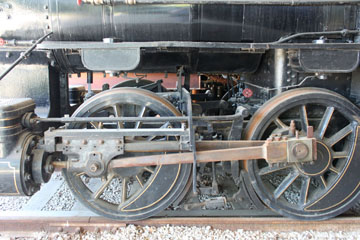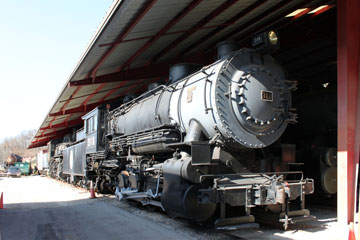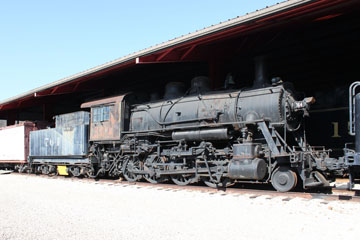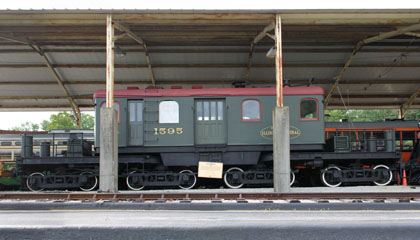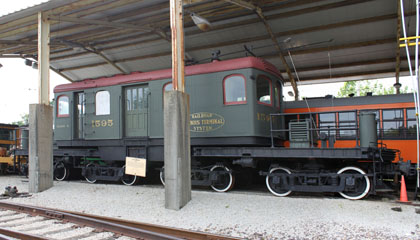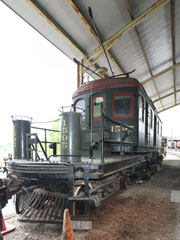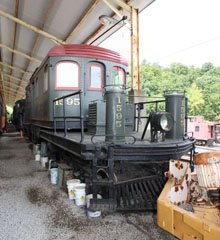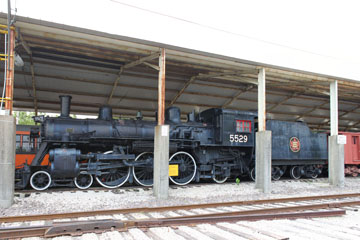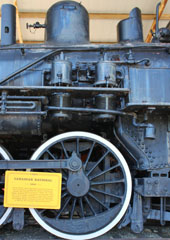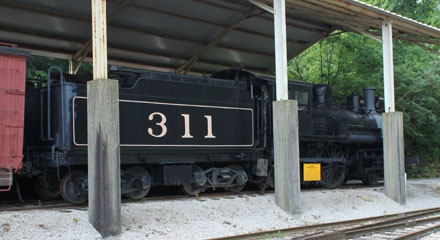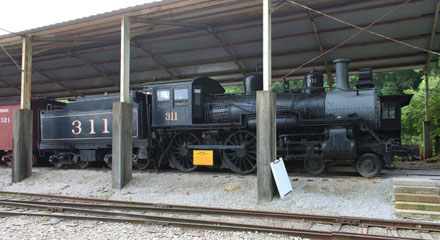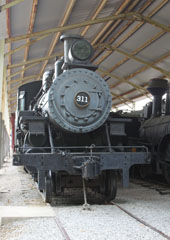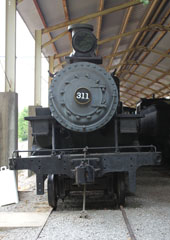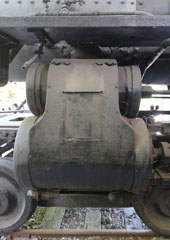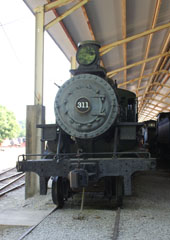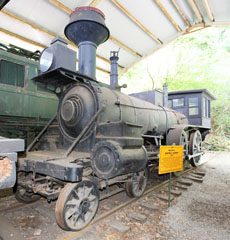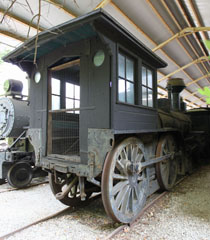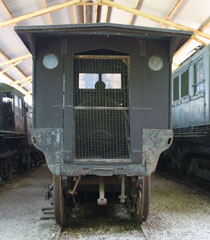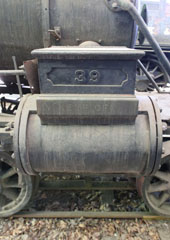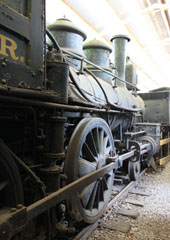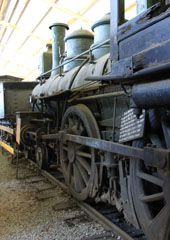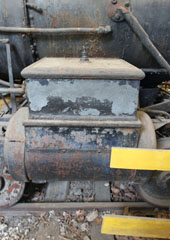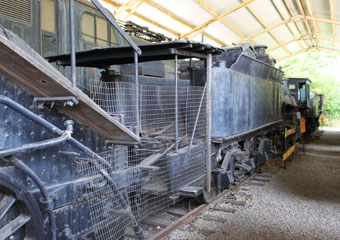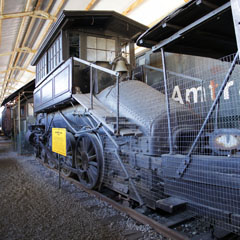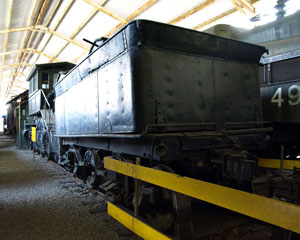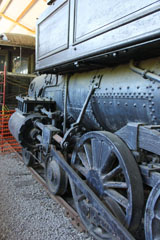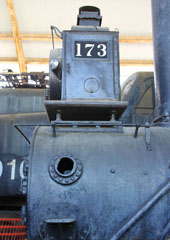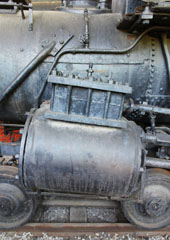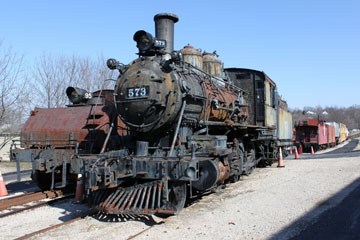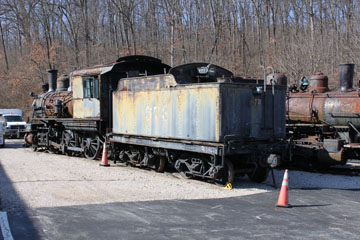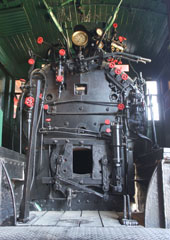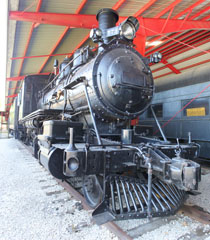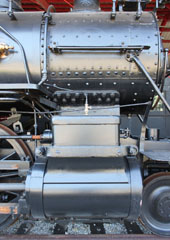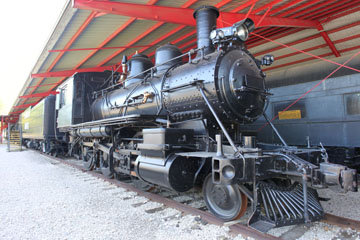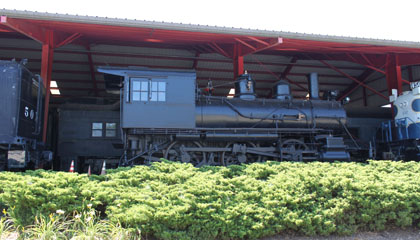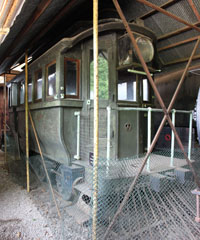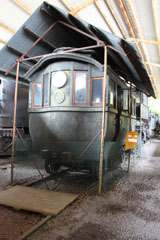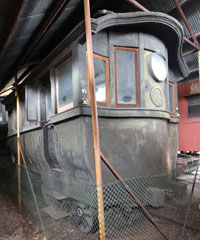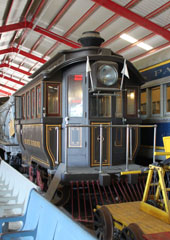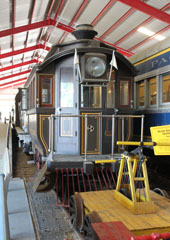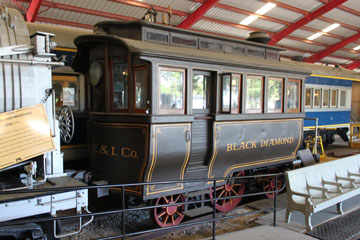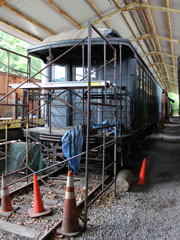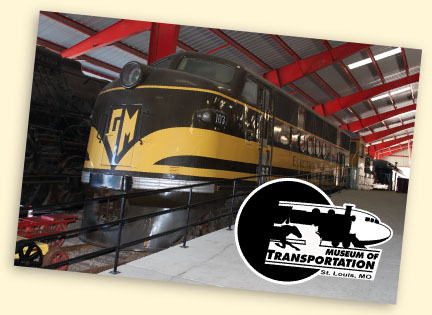

The National Museum of Transportation, St. Louis is located on Barratts Road in West St. Louis just off the I-270.
The museum was founded in 1944 by a group wanting to preserve historic transportation artefacts. After acquiring an 1870s mule-drawn street car, they formed the St Louis Railway Historical Society. The present site was identified for the museum, more streetcars were added, as well as a number of steam locomotives, and the collection continued to grow to include antique cars, boats and planes. It was taken over by the St. Louis County Parks Department in 1979, and remains a great collection, with some unusual pieces.
I have visited several times since 2008, and the photos are from various different visits.
Because of its size, I have broken the collection into two pages. This page shows locomotives that were stored in the two train sheds when I have visited, starting with Barretts Shed and then moving to the Abbott Shed. A separate page, the National Museum of Transportation, St. Louis Yard, shows locomotives that were stored outdoors.


Above, the 14,000 sq ft William R. and Laura Rand Orthwein Education and Visitor Center was completed in early 2012 at a cost of $2.2 million. It is dedicated to the local St. Louis American businessman and philanthropist and his wife. It serves as the ticket office and houses a small number of the museum's pieces, such as automobiles built in the St. Louis area, as well as featuring rotating exhibitions, the Box Car Boutique, a snack and gift shop.
Below, the miniature train arrives at the depot to the west of the Center.
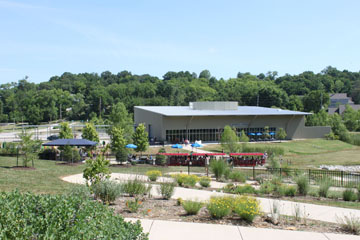

This mule hauled street car was built between 1870 and 1875 by the Andrew Wight Car Company of St. Louis, MO, at a cost of $700 and worked between downtown St. Louis and Bellefontaine in north St. Louis County until 1895.
Colloquially known as the "Bee Line" the Bellefontaine Railway Company was formed in 1868 from the consolidation of the Indianapolis Pittsburgh & Cleveland Railroad Company and the Bellefontaine & Indiana Railroad Company. Its line eventually ran from Cleveland, OH, to St. Louis, MO.
Passengers entered the car through the rear door and paid a nickel fare by placing it in the tall fare box in the front wall. The car had no heater. In the winter, the company spent three cents a day for straw to cover the floor.
Two-and-a-half cents a day lit the two oil lamps.
The driver was paid about nine-and-a-half cents per hour. The mule could only work six hours per day, but the driver worked much longer.After replacement by electric streetcars, #33 was used as a trolley line waiting room.
In 1921, the car was used as an example of an old car in comparison with the latest electrified ones. After this, it was stored until 1944 when its location was needed for other purposes and it was going to be scrapped. A small group of people who saved it formed the Museum of Transportation and this was the first Museum exhibit.

In 1893, the car was reconstructed with a new frame on old wheels under the supervision of its original designer, John Lightner for display that year at the World's Columbian Exposition in Chicago, IL.
After the fair, it was loaned to Purdue University to form part of a collection for the education of railway engineering students. In 1934, the New Haven Railroad, successor to the B&P, took it back to display with its new streamlined "Comet" train inaugurated in 1935. It later appeared at the New York World's Fair of 1939-40.
Built some time between 1834 and 1836 by John Lightner, master car builder of the Boston & Providence Railroad in its Roxbury, MA, shops, this is the oldest surviving original railroad passenger car in North America.
A "stage coach" style car, the body is suspended on leather straps ove the 4 wheel chasis. It was initially pulled by horses then, later, by steam locomotives. However, it was soon obsolete and was relegated to branch line work and then to track workers.At some time, it suffered a wreck and the pieces were gathered and kept in shops.
In 1951, the car was sold to the Danbury Connecticut Fair where it went on display as a historic transportation relic.
It stayed there until 1982 when the fair closed and it was bought at auction by the Museum of Transportation.


Twenty Y-5 class were then built at N&W's Roanoke shops between 1930 and 1932, thirty-five Y-6s between 1936 and 1940, sixteen Y-6as in 1942 and thirty Y-6bs from 1948 to 1952.
The Y-6 class locomotives were all state of the art, built with cast steel beds, fitted with Timken roller bearings on all axles, pressure and mechanical lubrication, and Baker valve gear with McGill multiroll bearings throughout. Like their predecessors, the Y-5s, the Y-6 class gained its distinctive look from the 8° forward slanted exhaust stack, which was designed to allow room for the front end throttle (the angle is just discernible in the panorama photo above), a slightly off-centre smoke box door, inverted "Y" exhaust and crossed handrails on the pilot deck, and the massive low slung front cylinders.
The Norfolk & Western 2-8-8-2 Y-6 is my favourite steam locomotive. A host of features, from its forward skewed exhaust stack through a sleek boiler to its slanted cab profile, low slung front cylinders and side mounted pumps, all speak of superior grunt power.
The N&W developed its Y class locomotives from five Y-1s built by Baldwin in 1910. These proved not particularly successful in operation and, by 1924, they had all been either scrapped or converted to 0-8-8-0s for yard service. Convinced of the utility of Mallets on its challenging mountainous profile, however, in 1918 the N&W turned out the first Y-2 from its Roanoke, VA, shops, and a revised Y-2a design followed in 1924. At the same time, inheriting fifty USRA 2-8-8-2s based on N&W's original Y-2 design in 1919 (forty-five built by Alco, five by Baldwin), the N&W brought these into its fleet as Y-3s. Thirty more 2-8-8-2s, designated Y-3a, were built by Alco in 1923 and, with increasing freight demands, the N&W took ten more in 1927, designated Y-4s.
The Y-6 locomotives primarily hauled freight across the Alleghany Summit in West Virginia (the "a" in "Alleghany" is a local spelling) but they also assisted other locomotives to take heavy freight across the Blue Ridge Mountains when required.
Like many of the N&W's steam locomotives, the Y class had a long life: on 6th May 1960, the last N&W steam locomotive to drop its fire was actually Y-6b #2190. #2156 was donated to the museum by Norfolk & Western in 1959.
The Y-6 is 103' 10" long and weighs 582,900 lbs. The overall engine wheel base is 58'. Weight on the drivers is 522,850 lbs and each driver wheel base is 15' 9".
The Y-6a has a 106.2 sq ft grate area, 430 sq ft firebox and total heating area of 7,422 sq ft, including 1,775 sq ft superheating. At 555 sq ft, the Y-6b had a larger firebox but less heating area (6,393 sq ft, including 1,478 sq ft superheating). Operating at a boiler pressure of 300 psi, the Y-6 delivered 126,831 lbs tractive effort.
Above, the inverted "Y" or "wishbone" exhaust was introduced with the Y-5 and subsequently retro-fitted to a number of earlier Y class locomotives during shopping. It was designed to allow the most unimpeded flow of exhaust from the front cylinders, thereby reducing back pressure. Also in these photos, the characteristic crossed handrails on the pilot. These first appeared with the Y-3a, and were then retro-fitted to some earlier Ys.
Below, the N&W favoured Baker valve gear, and all Y class locomotives from the Y-2a onwards were fitted accordingly.
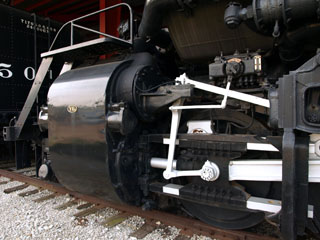
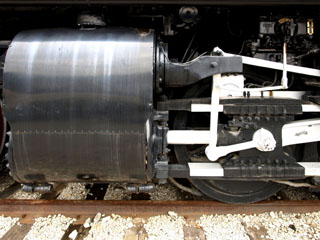
Top, the front low pressure cylinders are
39" x 32". Lower photo, the high pressure cylinders are 25" x 32". The low pressure piston valves measure 18" in diameter while the high pressure valves have a 14" bore. The drivers are 57" in diameter.
With a top speed of 50 mph, pound for pound the Y-6s were nevertheless arguably the most powerful steam locomotive ever built. They could produce 5,600 drawbar hp at 25 mph, perfectly suited to N&W's tonnage, grades and curves.
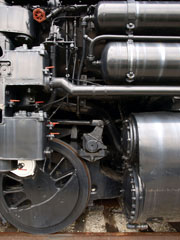
Worthington 4 1/2 BL-2 feedwaters (on the left in the photo above) were balanced by two cross compound air compressors on the other side of the locomotive.
A unique "booster" system on the Y-6 injected a burst of high pressure steam to the pipe to the front cylinders. Run simple,
Y-6s had a tractive effort of 152,206 lbs, although this was only utilised for starting or climbing short sharp grades. Once the locomotive reached 10 mph, power usually reverted to compounding, which produced tractive effort of 126,831 lbs.
The tender weighs 378,600 lbs light and has a capacity of 22,000 gallons of water and 30 tons of coal.
The tender is of a modern cast steel water bottom design and is fitted with two, three axle, six wheel trucks built by the Buckeye Steel Castings Co.
Above, a glimpse inside the cab.
The automatic stoker feed is visible running under the deck apron. The elevator casing runs at an angle upwards on the lower left of the photo. It encloses a screw that lifted coal to the firing plate inside the fire box.
In 1952, the N&W ran tests to compare a four-unit EMD F7 diesel consist against Y6b #2197, although several modifications were apparently made to
#2197, including a new booster and "intercepting/ reducing valve" which increased its drawbar horsepower by 26% and drawbar tractive effort by 15%. The tests showed that fuel and operating costs were roughly the same, and the competition was declared a tie. Still, diesels eventually won out even on the coal hauling Norfolk & Western because of their lower maintenance and operating costs.
#2156 went to the Virginia Museum of Transportation Museum in 2015 on a five year loan.

ATSF 5011 class #5011 was the first of twenty-five oil burning Texas type locomotives (2-10-4) built in 1944 by the Baldwin Locomotive Works in Philadelphia, PA, for fast freight service (#5011-#5035).
The railroad took delivery of its first purpose built Texas type, a coal burner, in 1930 (you can see that locomotive on the ATSF #5000 page of this website), and eventually rostered forty-fiveof the type. Because much of the AT&SF system ran through oil producing regions, oil burning locomotives were often preferred over coal.
#5011 is 123' 5" long with an engine wheelbase of 26' 2.5" and driver wheelbase of 50' 2.5". The engine weighs 536,000 lbs. It has Walschaert valve gear, 74" drivers and 30" x 34" cylinders.
The 5011 class represented the peak of rigid-wheelbase freight locomotive design, although their tall drivers meant they could successfully be used for passenger service. Features included Timken roller bearings fitted to all axles, including the tender trucks, Worthington 6SA feedwater heaters, cast-steel beds with integral cylinders and lightweight rods.
They were the last steam locomotives ordered by the AT&SF where they quickly nicknamed "War Babies" but they were amongst the best steam producers of their time. With a 121.7 sq ft grate, 494 sq ft firebox including 30 sq ft of thermic syphons, total heating surface was 8,577 sq ft, including 2,640 sq ft superheating. It operated at a boiler pressure of 310 psi delivering 108,961 lbs tractive effort.
The sixteen wheel tender weighs 462,700 lbs with a 7,000 gallon oil and 21,000 gallon water capacity.
Alhough capable of handling passenger assignments, the 5011s were basically freight locomotives throughout their careers.
All the 5011s had been retired from service by 1959. #5011 was donated to the museum in 1962. #5017, another of the class, is on the National Railroad Museum page of this website.

Chesapeake & Ohio K-4 class #2727 is a (2-8-4) Berkshire type, although known as a "Kanawha" on the C&O after the river that cut through its heartland in West Virginia.
The first fourteen K-4s delivered in 1943 (#2700-#2713) were built by Alco. You can see the first of these on the CO #2700 page of this website and #2705 on the B&O Museum Car Shop page. #2727 is one of twenty-six more ordered in 1944 (#2714-#2739). #2716 and #2736 are on the Kentucky Railway Museum and National Railroad Museum pages of this website.
The K-4 is 105' 2" long with an engine wheelbase of 42' and driver wheelbase of 18' 2.5". The engine weighs 460,000 lbs, 292,000 lbs on its 69" drivers. All axles were fitted with inside Timken roller bearings.
The engines were equiped with Baker valve
gear and Worthington Type 5½ S SA feedwater heaters, and had 26" x 34" cylinders. The 90.3 sq ft grates and 462 sq ft fireboxes were fed by Standard HT automatic stokers and included 103 sq ft provided by two thermic syphons and 19 sq ft in arch tubes.
Twenty more K-4s came from Lima, ten in 1945 (#2740-#2749) and ten in 1947 (#2750-#2759), and a further thirty were outdhopped by Alco in 1947 (#2760-#2789).
The K-4s were designed to haul the fast freight schedule demanded by WWII demands. They were based on the 2-8-4 design used on the Nickel Plate and Pere Marquette, which was common to the four railroads controlled by the Van Sweringen brothers. The K-4s were extremely successful, and operated over most of the C&O railroad's system hauling passenger trains as well as freight.
With a total heating surface of 6,705 sq ft, including 1,932 sq ft superheating, the K-4 operated at a boiler pressure of 245 psi, delivering tractive effort of 69,368 lbs.
By mid 1952, the C&O had built up sufficient numbers of diesels to begin systematically retiring its steam roster and, by 1957, all the K-4s had disappeared from service. Twelve of the class have been preserved. You can see more of them on the CO #2700 page of this website, the Baltimore & Ohio Railroad Museum Yard, CO #2732, CO #2755, CO #2760 and CO #2776 pages.

Class L1a #170 was the first of four Hudson type (4-6-4) locomotives built at Alco's Brooks works in Dunkirk, NY, in 1927 for the Nickel Plate Road (#170-#173) to haul heavy passenger trains. It was the second Hudson locomotive built.
New York Central J-1a #5200 was the first Hudson type built. Outshopped by Alco about a month before NKP #170 in February 1927, the locomotive design was developed and perfected by the NYC, which eventually rostered two hundred and seventy-five of the type (including the Michigan Central).
Most Hudson type locomotives, which were produced between 1927 and 1938, were built by Alco, but Baldwin and Lima also produced a number. As well as the four delivered by Alco, the Nickel Plate ordered another four Hudsons from Lima in 1929. Denominated class L-1b, they were numbered #174-#177. The "elephant ear" smoke lifters were a later addition.
For many years, their Hudson locomotives were the mainstay of the Nickel Plate's main line passenger service between Buffalo, NY, and Chicago, IL.
The NYC’s existing 4-6-2 Pacific locomotives had proved unable to haul the longer, heavier trains on that railroad’s system and, because of the axle load limits, the Pacifics could not be made any larger, which led to the new design.
The new Hudson type was therefore developed with a four wheel trailing truck to support a
larger firebox and extended boiler to deliver
more power. The four wheel trailing truck had been pioneered by the Berkshire type (2-8-4)
built in 1925 by Lima for the Boston & Albany Railroad.
Above, note the over-fire jets. These were designed to reduce smoke in built up areas. Left, #170’s tender weighs 206,200 lbs light and has a capacity of 11,000 gallons of water and 16 tons of coal.
The locomotive remained in service until 1947 when passenger trains on the Nickel Plate were taken over by diesels, but it continued in freight service for some years. #170 is the only surviving Nickel Plate Hudson and the oldest Hudson type still in existence. It was donated to the museum by the railroad in 1957.
#170 weighs 316,500 lbs, slightly heavier than
the later L-1b, which was 314,000 lbs. However, both locomotives were 85’ 7” long and had 25” x 26” cylinders and 73” drivers. The driver wheelbase is 13’ and weight on the drivers is 175,475 lbs.
Both classes of locomotive had 66.8 sq ft grates and 302 sq ft fireboxes. With a total heating
surface of 5,322 sq ft, including 1,103 sq ft superheating, they also both operated at a boiler pressure of 215 psi, delivering 40,680 lbs tractive effort.

It is 64' 6" long, weighs 395,500 lbs and has a GE FDL-16 prime mover powering a GT598 generator to drive six GE 752 traction motors, one on each axle.
It delivers 92,000 lbs starting tractive effort at 25% and continuous tractive effort of 79,500 lbs at 10.7 mph.
Above, this cutaway GE U28C was built for the Union Pacific in 1966. It is one of ten delivered to UP that year (#2800-#2809).
The U28C was developed by General Electric from its earlier U25C unit, with an increase in power from 2,500 to 2,800 hp.

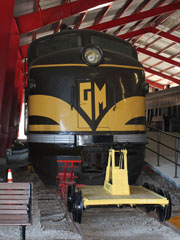

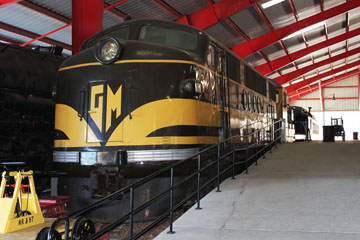
This is the "A" or lead unit of EMD's A-B set FT Demonstrator #103, built to promote the locomotive as a freight hauling diesel-electric (the "F" stood for freight, a "B" unit is a cabless coupled unit).
The set toured thirty-five states and twenty Class 1 railroads in 1939 and showed itself superior in operation and running costs to steam freight locomotives. It consequently convinced many railroads to convert to diesel power in the ensuing years and is the first in EMD's highly successful F series. One thousand and ninety-six FTs were built between 1939 and 1945.
A single FT unit mustered 1,350 hp, but they were marketed as semi-permanently coupled A-B sets making a single locomotive of 2,700 hp. The F series ran through F2, F3, F7, FP7, F9, FP9 and
FL9 models, and when the last F unit was
delivered in 1960, seven thousand, six hundred and thirty-eight had been built (4,734 A units and 2,904 B units.
#103 was sold to the Southern. The A unit was donated to the museum in 1961 by the Southern, and you can see the B unit on the Virginia Museum of Transportation page of this website

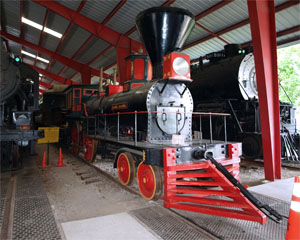
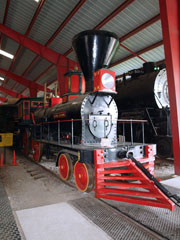

#17 "Daniel Nason" was designed by George Smith Griggs, Master Mechanic of the Boston & Providence from 1834 until his death in 1870. Griggs was one of the foremost designers of his day, and introduced many innovations to steam locomotive design including the firebox brick arch and the diamond stack.
Below, Griggs also designed and patented wrought iron "cushion wheels", which incorporated wooden wedges to extend the wheel's life.
#17 is an American type (4-4-0) coal burner built in the Boston & Providence Railroad's shops in Roxbury, MA, in 1858. It joined the Old Colony Railroad Co., as #170 in 1888, when the latter took a 99 year lease on the B&P. The New York, New Haven & Hartford took over the lease in 1893 and, in 1905, #170 was leased to Purdue University in Lafayette, IN. In 1951, it was sold to John Leahy of Danbury, CT, and then, in 1982, donated to the museum.
#17 weighs 52,650 lbs, and has 16" x 24" cylinders and 54" drivers.




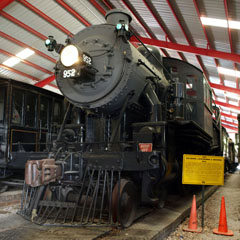
This is one of ten American type (4-4-0) Class G-3 locomotives built by Alco for the Delaware, Lackawanna & Western in 1905.
The engine wheelbase is 24' 5" and the driver wheelbase 8' 6". It weighs 156,000 lbs, 100,000 lbs
on its 67" drivers and has
20" x 26" cylinders. Operating at a boiler pressure of 185 psi, it delivered 23,700 lbs tractive
effort.
#952 is a "Mother Hubbard" locomotive, with its cab straddling the boiler (a true camel has its cab perched on top of the boiler and you can see one, BO #173, later on this page). The cab was positioned in
this way to allow for a very wide firebox.
Designed by John E. Wootten, Superintendent of Motive Power for the then Philadelphia & Reading Railroad, the Wootten firebox was fired with a thin layer of fuel and moderate draft, which produced a slow burning rate specifically to burn anthracite coal. This type of coal was high in carbon and gave off comparatively little smoke.
In 1939, #592 was donated to the Lackawanna Chapter of the RLHS, who then offered it to the museum on "permanent loan" in 1952. Efforts to transfer it to Steamtown have so far proved fruitless, as the museum will not give it up!

The Lake Street Elevated Railroad was the second elevated line built in Chicago, IL. The first section opened in 1893.
In 1924, it was merged into the Chicago Rapid Transit Company, and
the line is still in use as part of Chicago's 'L' system.
Built in 1893, #9 is a Forney type (0-4-4T). It weighs 60,000 lbs, has 44" drivers and 13" x 18" cylinders. An oil burner, it operated at a boiler pressure of 180 psi delivering tractive effort of 10,577 lbs. It is named after Charles H Deere, one of the Lake Street Elevated shareholders. It had a short life with the El, however.
In 1896, the line was electrified and #9 was sold. It passed through various owners in lumber, chemicals and steel. It was donated to the museum in 1957 and restored as far as possible to its 1893 appearance in 1995-1996.

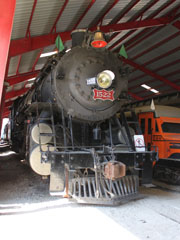
The St. Louis-San Francisco Railway purchased a total of thirty Mountain (4-8-2) type locomotives from Baldwin for freight and passenger service.
Fifteen (#1500-#1514) were delivered in 1923, five (#1515-#1519) in 1925 and the last ten (#1520-#1529) in 1926.
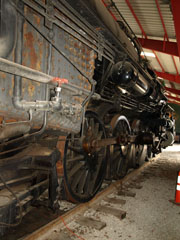
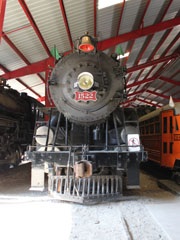

#1522 has a 40' 4" engine wheelbase, 18' driver wheelbase, 69" drivers, 28" x 28" cylinders, a 70.3 sq ft grate, 405 sq ft firebox and total heating surface of 5,620 sq ft including 1,180 superheating. It operated at a boiler pressure of 210 psi delivering 56,800 lbs tractive effort. The final ten, which included #1522, were the heaviest, weighing 360,890 lbs.
#1522 was built as a coal burner, but was converted to burn oil some time in the 1930s. It was also fitted with a booster on the rear truck. Retired in 1951, it was donated to the museum by SLSF in 1958. A group of steam fans known as the St. Louis Steam Train Association then restored #1522 to operating condition. It had its inaugural run to Dicatur, IL, in 1988 and then ran in many different states but, in 2002, the Association announced it could no longer afford to operate #1522 because of high insurance costs. On 28th September that year, #1522 ran a farewell excursion and the next day steamed back into retirement.
Five other SLSF Mountains have survived. You can see #1501 on the SLSF #1501 page of this website, #1519 on the Railroad Museum of Oklahoma, #1526 on the SLSF #1526 and #1527 on the SLSF #1527 page. #1529 is on display in Frisco Park, Amory, MS.

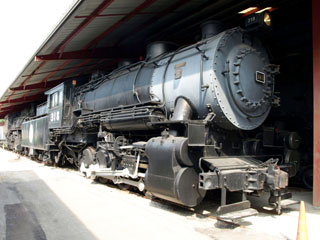

The Terminal Railroad was incorporated in 1889 to rationalise the interchange of freight and passengers in the St. Louis area, and was jointly owned by a number of Class I railroads, including the Missouri Pacific, the Wabash and Louisville & Nashville. It built the St. Louis Union Station in 1894, once the largest and busiest railroad station in the world, now a hotel, shopping and entertainment complex.
Today, the TRRA is owned by UP, BNSF, CSX, NS and Canadian National.
#318 was built at the Terminal Railroad's shops in Madison, IL, in
1926. An 0-8-0 switcher, it was the first engine to be built with a one
piece frame and cylinder casting, one of the precursors to locomotive design that made modern steam power possible. A coal burner
weighing 247,500 lbs, it has 51" drivers and 26" x 28" cylinders. It
operated at a boiler pressure of 205 psi and delivered tractive effort of 60,335 lbs.
At some time #318 was sold to Commonwealth Steel/General Steel Castings, and spent most of its life switching at the company's plant in Granite City, IL. Because of its historic significance, General Steel worked with the Terminal Railroad Association to ensure its preservation. In 1956, #318 was donated to the museum.

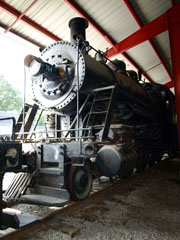
#764 is one of seven Consolidation (2-8-0)
type locomotives built by Alco for the Illinois Central in 1904. It was superheated in 1920.
#764 started on main line freight but was relegated to branch lines as heavier motive power arrived. It was donated to the museum by the IC in 1955.
Weighing 183,000 lbs, 163,000 lbs on its 51½" drivers, has 20" x 28" cylinders, a 54 sq ft
grate, 162 sq ft firebox and total heating surface of 2,598 sq ft including 458 sq ft superheating. Operating at a boiler pressure of 200 psi, it delivered 33,113 lbs tractive effort.

Taking their power from a 600 DC volt overhead line via a trolley pole, the eight 75 hp traction motors, one on each axle, produced 600 hp but could produce as much as 1,500 hp for short bursts.
At 52' 5" long and weighing 160,000 lbs, the units were
built on two 20' 7" cast steel frames. This, combined with the two independently swivelling trucks on each frame allowed them to negotiate tight, 35' radius curves and spread their weight so that they could operate on the system's relatively light rail. #1595 was donated to the St. Louis Transportation Museum by the Illinois Terminal Railroad in 1956.
The Illinois Terminal Railroad, known as the Illinois Traction System until 1937, was an inter urban electric railroad with five hundred and fifty miles of track serving passenger and freight business in central and southern Illinois. It operated from 1896 to 1982, with interchanges to major steam railroads at its terminal ends in Peoria and Danville, IL, and St. Louis, MO.
#1595 is one of twenty C class electric locomotives built in the railroad's Decatur, IL, shops in 1928 using trucks, traction motors and control equipment from retired passenger units. They were designed to haul the increasingly heavy freight trains operating on the system.

#5529 was built for fast passenger service.
In 1915, the Intercolonial joined the Canadian Government Railways, at which time #46 was renumbered #425. In 1919, the CGR became part of the Canadian National Railway when #425 became #5529.
This Pacific type (4-6-2) locomotive was outshopped as #346, one of fifteen built at the Montreal Locomotive Works, Alco's Canadian subsidiary, in 1905 for the Intercolonial Railway.
The Intercolonial was a government owned enterprise initiated in response to growing national concerns about the proximity of US Union troops south of the border and a background of historic US interest in the ceding of the Canadian territories. Sarted soon after confederation in 1867, by 1876, the road ran 700 miles from Quebec to Halifax.
#5529 weighs 195,560 lbs, 133,555 lbs on its 72" drivers, with a 31' 7" engine and 12' 7" driver wheelbase.
Equipped with Walschaert valve gear, it has 21" x 28" cylinders. With a 45¾ sq ft grate, 162 sq ft firebox and total heating surface of 2,660 sq ft, it operated at a boiler pressure of 200 psi delivering 29,115 lbs tractive effort.

This is one of six Class 195 American (4-4-0) type locomotives built for the Missouri-Kansas-Texas in 1890 by Burnham, Parry, Williams & Co., an early incarnation of the Baldwin Locomotive Works in Philadelphia, PA (#195-#201).
Starting out as #200, it was renumbered #280 in 1892 and
then #311 in 1912. As built, they had a 23' 8.5" engine wheelbase and 8' 8" driver wheelbase. They weighed 94,000 lbs, 63,000 lbs on their 63" drivers. With Stephenson valvr gear, 18" x 24" cylinders, a 17 sq ft grate and 125.75 sq ft firebox, total heating surface was 1,575 sq ft. Operating at a boiler pressure of 150 psi, they delivered 16,997 lbs of tractive effort.
In 1923, they were converted to burn oil and
rebuilt as class E3 by the MKT with larger drivers, smaller grates, piston valves and superheaters.Engine weight increased to 123,000 lbs, 76,400 lbs on the new 69" drivers. The grate went down to 15.6 sq ft, although the firebox increased to 132 sq ft. Total heating surface was 1,480 sq ft including 267 sq ft superheating. Operating at a boiler pressure of 180 psi, they delivered 17,242 lbs tractive effort.
The E3s stayed in service until the end of steam on the Katy in 1954.

Eddy Wilson started as an apprentice engineer at the Western Railroad of Massachusetts, merged into the B&A in 1867. In 1840, he became foreman at the B&A's Springfield, MA, shops and, by 1850 had risen to Master Mechanic.
The first locomotive Eddy built was a 4-2-2, but the two drivers did not provide sufficient adhesion. Most of his subsequent locomotives were 4-4-0s, the extra two drivers providing the required adhesion. Their fine proportions, reliability and easy maintenance gained these 4-4-0s the name "Eddy Clocks".
Built at the Springfield, MA, shops of the Boston & Albany in 1873 for passenger service, #39 was named "Marmora". It is an American (4-4-0) type and the sole surviving example of an "Eddy Clock" locomotive. It is one of about one hundred built in the second half of the nineteenth century.
Named after its designer, Wilson Eddy, Master Mechanic of the Boston & Albany, the "Eddy Clock" has no steam dome (the box atop the boiler is a sand box). Instead, two steam cannons released pressure from the boiler. The straight top boiler is an Eddy feature (most locomotives at the time had wagon top boilers), as are its 73" drivers (typical passenger locomotives of the time had drivers of 60"-70").
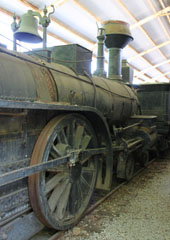
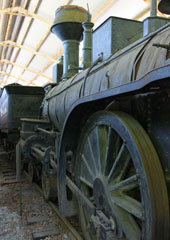
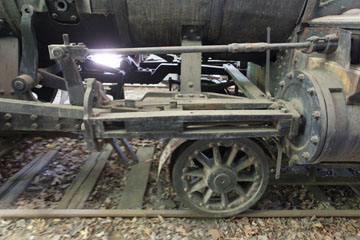
#39 was a coal burner weighing 68,000 lbs, with Stephenson valve gear and 18" x 26" cylinders. The engine was originally named the "Ontario" but, at a later date, became the "Marmora". A total of two hundred and thirty locomotives were built at the B&A shops.
#39 was leased to the New York Central & Hudson River Railroad in 1899 when and was last used as a stationary boiler. In 1908, it was donated to Purdue University, Lafayette, IN. At some time in the 1920s, the boiler was lost. It was donated to the museum in 1951.


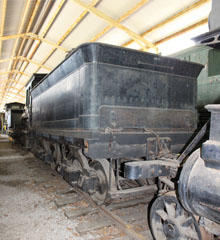
Built by Baldwin in 1873 for the Chicago & Northwestern, #274 is an American type locomotive (4-4-0).
The engine and tender still have their rigid couplers with a slotted knuckle to connect with link and pin couplers. The knuckle and pin release mechanism are visible on the rear of the tender in the lower photo above.
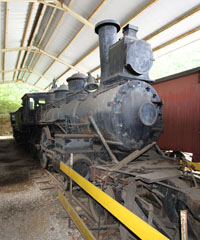
A coal burner, #274 weighs 74,000 lbs, 46,000 lbs on its 63" drivers. With 16" x 24" cylinders, it operated at a boiler pressure of 130 psi delivering 12,100 lbs tractive effort.
At some point, the locomotive was leased to the Winona & St. Peter Railroad, a line running across the state of Minnesota to the James River in the Dakota Territory, as #40. In 1882, it was renumbered #1900 and, later, #1040.
The C&NW took over the Winona & St. Peter in 1900. Eight years later, they donated #274 to Purdue University, Lafayette, IN, who then donated the locomotive to the museum in 1951.

#173, a 4-6-0 (Ten Wheeler)
type, is a true camel back: it’s
cab is mounted on top of the boiler, rather than straddling it. The latter configuration, such as DLW #952 earlier on this page, should be known as a “Mother Hubbard”.
The first 0-8-0 camel backs were designed for the B&O by Ross Winans, an independent locomotive builder.
The 4-6-0 improved on earlier 0-6-0 B&O camel backs by adding a four wheel leading truck, which improved running stability, and they continued in production into the 1870s.
Built as #373 in 1873 for freight service, this locomotive was renumbered #173 in 1884. It weighs 77,100 lbs and has 47” drivers and 19” x 22” cylinders. It operated at a boiler pressure of 65 psi and delivered tractive effort of 8,775 lbs. In 1901, the B&O donated the locomotive to Purdue University in Lafayette, IN, who then donated it to the museum in 1951.
Winans’ works were situated next to the Baltimore & Ohio’s Mt. Clare shops in Baltimore, MD, and he built one hundred and nineteen 0-8-0 camel backs for the railroad between 1848 and 1857.
In 1853, Samuel J. Hayes, Master Mechanic for the B&O, designed the first 4-6-0 camel back, which was built at the B&O Mt. Clare shops.

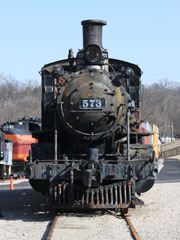
Class F4 #573 is a
Mogul (2-6-0) type locomotive built as cross compound Class F5 #754 in 1899 by the Rhode Island Locomotive Works. In 1915, it was simpled and renumbered #573.
As built, #754 weighed 123,525 lbs, 105,525 lbs on its 63" drivers with a 22' 7" engine wheelbase and 14' driver wheelbase. The high pressure cylinder was 20.5" x 28" and the low pressure 32.5" x 28".
With a 31.97 sq ft grate, 163.96 sq ft firebox and total heating surface of 1,607, it operated at a boiler pressure of 195 psi delivering 22,147 lbs tractive effort.
With a slight decrease in the engine wheelbase and the 19" x 28" cylinders, not much changed with the 1915 rebuild although tractive effort rose to 26,594 lbs.
#573 was kept for two years after the Wabash dieselised because a bridge across the Illinois River at Bluffs, IL, would not support the heavier diesel locomotives.

Above, when I first visited the museum, this 2-2-2T (Tank) locomotive was very much in need of restoration. However, far right, on my most recent visit, it had been beautifully restored.
"Black Diamond" is one of the very few surviving US steam powered railroad inspection engines.
The twelve engines were used by company officers, managers and road foreman to inspect road work and construction projects out on the road.
They also acted as a paymaster’s office for paying track building and repair crews on the job.
With 42" drivers, Stephenson valve gear, a 9.1 sq ft grate and 8¼" x 8½" cylinders, the "Black Diamond" weighs 26,350 lbs, 9,070 lbs on its drivers. Operating at a boiler pressure of 160 psi it delivered 1,871 lbs tractive effort. The internal tender had a capacity of 280 gallons of water.
The interior was designed for VIP passengers with walnut panelling and seating for eight. The bands on the boiler were "Russian iron" in the cab and brass in the passenger section. The limited area behind the firebox, meant it had to be fired by a small boy.

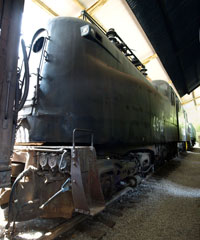
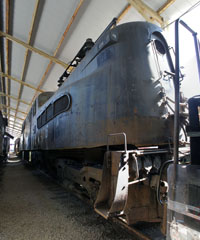
Cramped conditions in the train shed make it difficult to get a good picture of this GG1. It was built as PRR #4918 in 1942 at Pennsy's Altoona shops at a cost of $250,000. It retained the number #4918 when Penn Central was formed from the amalgamation of the Pennsy and New York Central in 1968. When Amtrak took over main line passenger services in 1971, however, #4918 was transferred and renumbered #916. At some time, Amtrak renumbered it #4916. Retired in 1982, it was bought by Edmund Joyce Jr., and donated to the museum.
The GG1 was designed to haul 12-14 car passenger trains on the Pennsy's electrified Northeast Corridor between Harrisburg and Philadelphia, PA, New York City and Washington, DC. The unit drew power from a 25 Hertz 11,000 Volt AC current transmitted from overhead electrical wires through a pantograph. Twelve 385 hp GEA-627-A1 traction motors drove six 57" driving wheels on three axles using a quill drive, easily producing the desired speeds of 100 mph plus.
Sixteen GG1s have survived, although none is operational. You can see the first GG1 #4800 on the Pennsylvania Railroad Museum Yard page of this website, #4890 on the National Railroad Museum page, #4903 on the Museum of the American Railroad page and #4919 on the Virginia Museum of Transportation page.

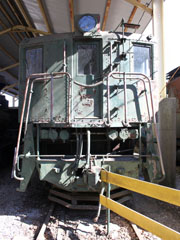
This is one of two prototype P5 electric locomotives built by the Pennsy in 1931.
Ninety more P5s were produced from 1932 to 1935 designated P5a, by Westinghouse (fifty-four units), General Electric (twenty-five) and PRR at its Altoona shops (ten).


The GE units were built at its Erie, PA, plant. Assembly of the Westinghouse units was subcontracted to Baldwin. The design was by both companies and PRR's electrical department, and the equipment was identical whoever produced the units.
The P5 is 62' 8" long and weighs 392,000 lbs. With a top speed of 90 mph, it was powered by six 625 hp motors, two on each of its three centre drive axles, fed by an 11,000 volt AC overhead pantograph. With the advent of the GG1 in the late 1930s, the P5s were regeared to 70 mph and relegated to freight service.
Originally #7898, this unit was renumbered #4700 in 1933. It was donated to the museum in 1966 by the Pennsy.

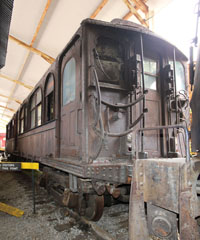
Subway car #256 was built in 1909 by the Pressed Steel Car Company of New Jersey for the Hudson & Manhattan Railroad Company.
The railroad connected Hoboken, NJ, with Manhattan, NY, through two parallel tunnels under the Hudson River. Although tunnelling started in 1890, funding crises and collapses stalled work, and the railroad only began operating in 1907, with the first revenue service on 26th February 1908. It was taken over by the Port Authority Trans-Hudson (PATH) in the 1960s.
#256 has a total passenger capacity of one hundred and twenty-five, with forty-four seats.
Related Links:
Location of the National Museum of Transportation, St. Louis
National Museum of Transportation, St. Louis Website
Norfolk & Western Historical Society
ATSF Rail Fan Site
Chesapeake & Ohio Historical Society
Nickel Plate Road Historical & Technical Society
Burlington Route Historical Society
Delaware, Lackawanna & Western Railroad Historical Society
Santa Fe Railway Historical & Modeling Society
Illinois Central Net
Katy Railroad Historical Society
Pennsylvania Railroad Technical & Historical Society
Send a comment or query, or request permission to re-use an image.
Two very good books on the N&W Y class: William F. Warden, Norfolk & Western Railway's Magnificent Mallets, The Y Class 2-8-8-2s, TLC Publishing, 1993, or Thomas W Dixon Jr's., Norfolk & Western's Y-Class Articulated Steam Locomotives, based on Warden's earlier tile, TLC publishing 2010, if you can get over some quite egregeous typos in the latter (click on the cover of either book to search for it on Bookfinder.com).








